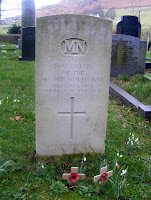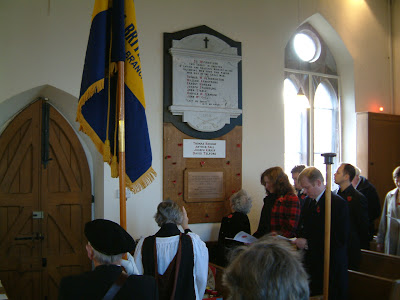Most churches and churchyards in the county have multiple memorials of one sort or another. That at Whicham, a little chapel tucked beneath the slopes of Black Combe, has more than most.

Best known perhaps for having the grave of Tom Mayson, a local man who won the Victoria Cross at Passchendaele in 1917, it hosts a number of other memorials that illustrate the ubiquity of loss in the conflicts of the twentieth century.
 Three unknown merchant seamen are buried here, their place marked with Commonwealth War Graves Commission headstones. Two of them share a common grave and must have been found on the beach off Silecroft on the same day in April 1941. They are a stark reminder of the Battle of the Atlantic during which long campaign over 50,000 merchant seamen of many nations perished, their bodies occassionally thrown up by the ocean and given anonymous burial. The courage, commitment & tenacity of those remarkable men is rarely acknowledged.
Three unknown merchant seamen are buried here, their place marked with Commonwealth War Graves Commission headstones. Two of them share a common grave and must have been found on the beach off Silecroft on the same day in April 1941. They are a stark reminder of the Battle of the Atlantic during which long campaign over 50,000 merchant seamen of many nations perished, their bodies occassionally thrown up by the ocean and given anonymous burial. The courage, commitment & tenacity of those remarkable men is rarely acknowledged.Check out http://www.gordonmumford.com/m-navy4.htm and the Tower Hill memorial on the CWGC website for the endless lists of 35,808 names.
Next to this are two further CWGC headstones marking the graves of two Australian airmen, 27 year old Corporal Clifford Amos of South Australia & A/C John Francis aged 22 of New South Wales. Both were crew members of a Short Sunderland flying boat of number 10 squadron RAAF that came down in the sea off Anglesey. Their bodies were washed up at Silecroft some time later.
On the south side of the church is a plot belonging to the Caddy - Huddlestone family that contains a family headstone and two more CWGC graves. The earlier war grave is that of Private Tom Caddy who, having served with the Machine Gun Corps, died of the effects of gas poisoning in March 1920. The later one is that of his nephew, Sgt Tom Huddlestone, Wireless Operator/Air Gunner, RAF, who died on October 2, 1944 aged 19. On the family headstone is the name of Annie May Huddlestone, nee Caddy, sister of one, mother of the other.

Inside the church are three memorials, one each for the world wars and a copy of the citation for Tom Mayson's VC. The orginal was, unbelievably, stolen in the early 1990s.















 Although an armistice that silenced the guns was signed on November 11, 1918 between Germany and the allies, it was not peace. People remained wary, hardly able to believe that the conflict had ended. Indeed the vicar at Hawkshead reminded his flock at Christmas 1918 that peace had not been declared and that men continued to die in great numbers in hospitals across the country. Only after the signing of the peace treaty at Versailles on June 28
Although an armistice that silenced the guns was signed on November 11, 1918 between Germany and the allies, it was not peace. People remained wary, hardly able to believe that the conflict had ended. Indeed the vicar at Hawkshead reminded his flock at Christmas 1918 that peace had not been declared and that men continued to die in great numbers in hospitals across the country. Only after the signing of the peace treaty at Versailles on June 28

 Unusually it has been further embellished with a substantial frame decorated with regimental badges. It is not unreasonable to imagine that these may have been worn by village soldiers, and that their inclusion added a further degree of intimacy between memorial and veteran. The picture of the soldier appears on a number of other rolls in the county.
Unusually it has been further embellished with a substantial frame decorated with regimental badges. It is not unreasonable to imagine that these may have been worn by village soldiers, and that their inclusion added a further degree of intimacy between memorial and veteran. The picture of the soldier appears on a number of other rolls in the county.
